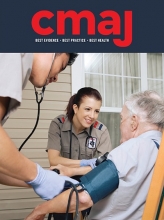Increasingly, paramedics are being recognized as uniquely positioned to deliver sustainable and high-quality health care in the community.
Community paramedicine began as a grassroots movement among paramedics who recognized a need for new services that emphasized a more proactive and preventive approach to care by using paramedics in expanded roles.
The findings of several studies suggest that community paramedicine programs can be effective in improving health outcomes for some populations, can reduce use of emergency services and may lower costs to the health care system.
Increasingly, paramedics are being recognized as uniquely positioned to support sustainable and high-quality health care delivery to Canada’s aging population. In some Canadian jurisdictions, unnecessary 911 calls and emergency department visits have been rising by as much as 8% annually.1 Because paramedics initiate care for people in their own homes and communities, these health care professionals are well placed to recognize the unmet needs of the community-dwelling individuals they serve and to act proactively to support efforts to stem unnecessary use of emergency medical services.
The umbrella term, “community paramedicine,” describes a growing field that began as a grassroots movement among paramedics who recognized a need and had the flexibility to create new services that emphasized a more proactive and preventive approach to care that utilizes paramedics in expanded roles.2 For example, across Canada and elsewhere, paramedics are increasingly conducting scheduled preventive home visits to improve chronic disease management in rural and remote regions.3 In other models, paramedics are using their unscheduled emergency encounters as an opportunity to refer their patients with unmet needs to home and community care services to prevent future unnecessary calls to 911 services and transports to the emergency department.4 These community paramedicine programs have been shown to improve care for community-dwelling individuals and reduce the unnecessary use of costly ambulance and hospital-based services.3,4
Research around this novel and rapidly evolving area of practice, however, remains limited. Two recent systematic reviews identified only 11 studies that evaluated community paramedicine and concluded that, although these programs appeared promising, further research about their effectiveness was needed.1,5 In linked research, Agarwal and colleagues describe a cluster randomized trial of a preventive wellness clinic-based model of community paramedicine within social-housing buildings.6 The trial’s Community Paramedicine at Clinic (CP@clinic) chronic disease risk assessment and management program is a unique example of a partnership between community paramedics, primary care and providers of social housing to address a variety of unmet patient needs among a vulnerable population that are frequent users of 911 services and characterized as having higher mortality rates and poorer health-related quality of life and health because of higher rates of chronic disease among this population. This trial contributes further empiric evidence about the effect and potential for widespread adoption of community paramedicine programs.
Community paramedics have developed such pragmatic and collaborative approaches to care because they are a ubiquitous, highly skilled and mobile segment of the workforce who are interested in bridging gaps between service providers and stakeholders. These efforts are proving to be effective at both improving the quality and experience of patient care, and reducing overall costs of health care.7
The study by Agarwal and colleagues shows that patients with chronic conditions can benefit from improved access to health care resources and services in a familiar setting through the establishment of trusting relationships with local providers of paramedic services.6 The trial further highlights the potential value of deploying a low-cost community paramedicine intervention in a high-risk social-housing setting, because it showed a significant difference in the number of ambulance calls between participants who received the intervention (i.e., attending the CP@clinic) and controls.
Although improvements in health-related quality of life and function reported at the patient level are important, it is the potential of community paramedicine programs to reduce future ambulance calls and resulting visits to the emergency department and, as a result, wait times for both emergency department and routine paramedic services, that is motivating jurisdictions across Canada to continue to invest in the development of community paramedicine models. Indeed, in rural Nova Scotia, a community paramedicine program developed to address a shortage of available primary care services reduced annual trips to emergency departments by 40% and decreased overall annual expenses for health care from $2380 to $1375 per person.7 In rural Ontario, a community paramedicine program targeted around medically complex high users reduced 911 activation by 24%, emergency department visits by 20% and admissions to hospital after emergency department visits by 55% one year after implementation.8 Despite consistency of findings, the before-and-after design of these and most current studies will always limit the interpretation of their results because “regression to the mean” cannot be ruled out. Therefore, the findings from Agarwal and colleagues’ trial6 help to strengthen the evidence base that supports the effectiveness of initiatives in community paramedicine for both patient and system outcomes.
As Canada’s population ages and the complexity of patients’ needs continues to increase, heath care systems will need to adapt resource allocation to ensure improved patient care and system efficiency. The promise and potential of paramedicine practice to evolve beyond traditional emergency response is being realized across Canada and beyond. As governments continue to invest in the expansion of these services, service standards are being established,9 and standardized training of paramedics to provide community paramedicine programs is becoming commonplace. To support these efforts, more robust research is required to define an evidence-based framework on which to base new and existing programs that will further advance the delivery of health care and the overall sustainability of our health care systems.
Footnotes
Competing interests: None declared.
This article was solicited and has not been peer reviewed.
Contributors: Katherine Nolan performed the literature review. All of the authors drafted the manuscript, revised it critically for important intellectual content, gave final approval of the version to be published and agreed to be accountable for all aspects of the work.








